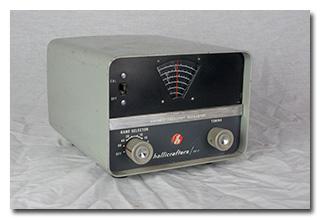
by William Eric McFadden
From the manual:
-
The new Hallicrafers Model HA-5 is a compact, self-contained, Variable Frequency Oscillator (VFO) designed as a crystal substitute for use with any conventional, 80 through 2* meter, amateur transmitter.Heterodyne operation plus voltage regulation of the tunable and crystal oscillators insures maximum frequency stability. A 30 to 1 tuning ratio, in conjunction with an as easy-to-read back-lighted dial calibrated directly in operating frequency for each band, provides precise frequency adjustment.For ease and flexibility of operation, a single control turns the power ON and selects the desired output frequency range.A convenient front panel CAL swith permits instantaneous spotting of the transmitter frequency with the station receiver.* The unit, as supplied, does not include heterodyne crystals for the 6-meter or 2-meter bands. Should operation be desired on either of these bands, the heterodyne crystals may be purchased and installed.
SPECIFICATIONS: TUBES 6U8A Tunable Oscillator, Crystal Oscillator
6BA7 Mixer
6AQ5A Output Amplifier
OA2 Voltage RegulatorRECTIFIERS Silicon (2) OUTPUT IMPEDANCE 5600 ohms shunted bu 100μμF cable capacitance OUTPUT VOLTAGE 30V Nominal STABILITY Better than 500 cycles of set frequency over a one hour period (after 15-minute warmup) POWER CONSUMPTION 30 watts at 117 volts (nomimal), 60 CPS, alternating current DIMENSIONS (H x W x D) 5-5/8 inches x 7 inches x 9-1/32 inches NET WEIGHT 7 pounds SHIPPING WEIGHT 8-1/2 pounds
I acquired my very clean Hallicrafters HA-5 at Hamvention 2016 to use with my Drake 2-NT CW transmitter, which I also had purchased at the 2016 Dayton Hamvention. The seller thought the VFO was functional but could give no concrete assurances.
After running my 2-NT "rock-bound" for several months, I finally decided to verify operation of the HA-5. My boat-anchor elmer, KB8TAD (link) was unavailable to help me with power-up and testing of the VFO. He did, however, send me instructions via email on how to construct and use a "dim bulb tester" in order to safely perform the inital power-up and tests.
Using a "dim bulb tester", I was able to confirm that the HA-5's built-in power supply was healthy and that the the VFO provides accurate and stable output on 80m, 40m, 20m, and 15m bands.
I've enjoyed using the HA-5 with the 2-NT for regular ragchew-QSOs on 80m and have used the pair on 40m and 80m during the Classic Exchange, during the Novice Rig Roundup, and for other QSOs. The HA-5 / 2-NT pair work beautifully together.
UPDATE 2017-02-27: I received only reports of a very nice note from my Drake 2-NT / Hallicrafters HA-5 during the Novice Rig Roundup 2017 event but during my very first rag-chew following the week-long event K8RAT reported a slight instability in my transmitted signal which he has taken to calling a "wooble". A switch to a known-good crystal confirmed that the 2-NT itself is healthy and that the problem is in the HA-5 or the connecting cables. I've been able to hear the instability myself while listening on the 2-C; it's not a classic chirp but an occasional warble in the transmitted tone. I will have to determine what is happening. Is it time for me to re-cap the HA-5? Do I need to check resistor values?
UPDATE 2017-04-27: While poking around inside the HA-5 to try to fix the "wooble" I discovered one of the two 0.01µF 1400-volt ceramic capacitors between the AC cord and chassis-ground was burnt-open. (Indeed, half of the capacitor was completely gone. (I suspect the VFO took a lightning strike while still in the station of a former owner.) At the recommendation of KB8TAD, I replaced the two-conductor AC cord with a three-conductor AC cord, adding a fuse on the hot side of the AC cord before the power switch, using the one good 1400-volt ceramic capacitor on the hot leg of the AC cord, and adding a 0.01µF 500-volt ceramic capacitor on the neutral leg of the AC cord. While testing the HA-5 after performing this modification, I found my VFO-Key cable to be intermittent at the RCA connector, so I made a new VFO-Key cable. I have not yet determined if either of these things fixed the "wooble" but until I can give the HA-5 a thorough test, I'm minimizing expectations.
UPDATE 2017-08-31: Periodic use of the Drake Novice station with the HA-5 VFO has disclosed that the power supply repairs did not fix the "wooble" problem. However, I have come to the conclusion that the "wooble" might be related to a dirty tuning capacitor wiper because making large excursions with the VFO seems to make the "wooble" go away. My next step will be to open the HA-5 and clean the capacitor, and while I'm poking around, I'll clean the bandswitch to see if this bring proper performance on the bands above 40m.
UPDATE 2017-11-22: After getting reports of a "buzzy" CW note, at the recommendation of KB8TAD, I verified the problem isn't a ground-loop issue and Rich gave me 22µF and 100µF electrolytic caps to replace the original multi-cap. When I opened the VFO to replace the caps, I found that a power resistor connected to the original 20µF cap wasn't soldered well. I re-soldered this connection and now need to get some signal reports so I can determine if I still need to replace the original caps.
UPDATE 2017-11-25: After installing the replacement 22µF and 100µF electrolytic caps in place of the original multi-cap—leaving the original cap in place for cosmetics—the "buzzy" CW note was replaced by a pure CW note.
